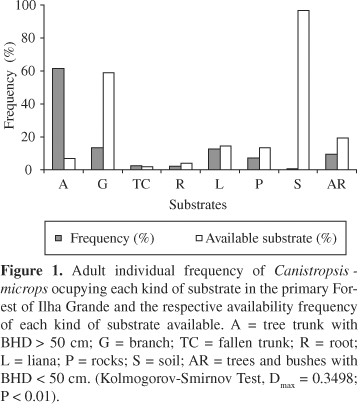Canistropsis microps (Bromeliaceae: Bromelioideae) is an endemic species of Atlantic rain forest areas in Rio de Janeiro State, which are very abundant in not very disturbed forests in Ilha Grande, on the southern coast of the State. In this study, we analyzed the vertical and horizontal distribution patterns of the species in an area of rain forest with little evidence of disturbance at Vila Dois Rios, Ilha Grande, relating the patterns to sunlight in the microhabitat. We also identified the types of substrate used by the species and the rate of asexual reproduction. Canistropsis microps had high densities (estimated at 84,425 rosettes/ha), and has an aggregated distribution (Id = 2.86). About 80% of the rosettes were generated by clonal growth, whereas less than 20% were produced from seedlings. Most of the rosettes were found on straight tree trunks (DBH > 50 cm). There was a significant inverse correlation between the incidence of sunlight in the habitat and the abundance of individuals. Rosettes were found up to a maximum height of 9.5 m, but most occured between 1.5 and 5.5 m, where light varied from 25 to 50 µmol.s-1.m-2. We conclude that vertical and horizontal distribution patterns in C. microps may be partially explained by the occurrence of appropriate substrate, an intensity of sunlight favorable to the development of the species and to a high rate of vegetative reproduction.
Canistropsis microps; Bromeliaceae; spatial distribution; substrate; Atlantic Rainforest






